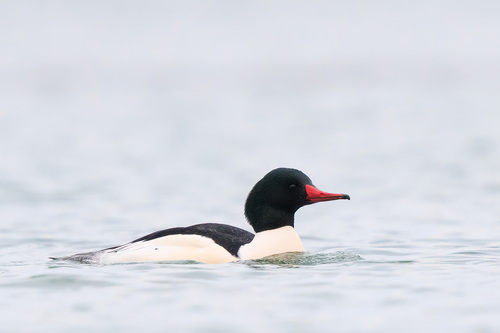
Common Merganser
The Common Merganser (Mergus merganser) is a large diving duck found across North America, Europe, and Asia. Known for its sleek body, serrated bill, and distinctive crest, it is a skilled predator of fish in freshwater habitats. This species plays a crucial role in its ecosystem as an indicator species, reflecting the health of aquatic environments. While not of major cultural significance, it is a favored subject for birdwatchers and wildlife photographers due to its striking appearance and active behavior.
58-72 cm
Length
78-97 cm
Wingspan
Least Concern
Conservation Status
Distribution
The Common Merganser has a Holarctic distribution, breeding across North America, Europe, and Asia. In North America, it breeds from Alaska across Canada and the northern United States. In Eurasia, it is found from Iceland and the British Isles across Scandinavia, Russia, and into parts of Central Asia. It migrates south in winter to ice-free coastal areas and inland lakes and rivers.
Lifespan
Up to 13 years in the wild, though average lifespan is likely shorter.
Common Merganser's Habitat
Habitat Types
Rivers, Lakes, Reservoirs, Coastal bays (in winter)
Climate Zones
Temperate, Boreal, Subarctic
Adaptations
Their streamlined body and webbed feet enable efficient underwater pursuit of prey. The serrated bill helps them grip slippery fish.
Variations
Three subspecies are generally recognized: *M. m. merganser* (Eurasia), *M. m. americanus* (North America), and *M. m. orientalis* (Central Asia). There are slight differences in size and plumage coloration.
Appearance
Breeding Plumage
Breeding males have a dark green head, white body, and black back. Females and non-breeding males have a reddish-brown head and gray body.
Seasonal Feather Changes
Males undergo an eclipse plumage after breeding, resembling females, before molting back into breeding plumage.
Sex Based Plumage Differences
Significant. Males are larger and more brightly colored, especially during breeding season.
Notable Features
Serrated bill for grasping fish, Shaggy crest on the head (more prominent in males), Streamlined body shape for diving
Diet and Feeding
Primary Foods
Small fish, Aquatic invertebrates, Crustaceans, Amphibians (occasionally)
Foraging Behavior
Dives underwater to pursue prey, using its excellent underwater vision. Often forages in groups, sometimes herding fish into shallow water.
Specializations
The serrated bill is a key adaptation for catching and holding slippery fish.
Seasonal Diet Variations
Diet may shift slightly depending on prey availability, with more invertebrates consumed during breeding season when chicks need protein-rich food.
Behavior
Social Structure
Generally gregarious, especially outside of breeding season. Forms large flocks during migration and on wintering grounds.
Communication
Soft, croaking calls, Visual displays during courtship, Whistling wings during flight
Migration
Migratory in northern parts of its range. Migrates south to ice-free areas for winter. Migration routes are generally along coastlines and major river systems.
Territorial or Group Behaviors
Females defend nesting territories, but otherwise, the species is not highly territorial. Forages cooperatively in groups.
Conservation
Threats
Habitat loss (especially of mature forests with suitable nesting cavities), Water pollution, Disturbance at breeding sites, Hunting (in some areas)
Protection Programs
Provision of nest boxes, Habitat restoration projects, Monitoring of populations, Regulations on hunting
Local National Laws
Protected under the Migratory Bird Treaty Act in North America and similar legislation in other countries.
Population Trend
Stable
Population Estimates
Global population estimated at 1.7-2.5 million individuals.
Interesting Facts
They are nicknamed 'sawbills'
Due to their serrated bills.
They can stay underwater for up to 2 minutes
Although dives are usually shorter, around 30 seconds.
Chicks leap from high nest cavities
Often from considerable heights, shortly after hatching, relying on their downy feathers to cushion the fall.
Faqs about Common Merganser
What is the difference between a male and female Common Merganser?
Males have a dark green head and white body, while females have a reddish-brown head and gray body.
Where do Common Mergansers nest?
They nest in tree cavities, rock crevices, or nest boxes, usually near water.
Are Common Mergansers endangered?
No, they are classified as Least Concern by the IUCN.
What do Common Merganser chicks eat?
Newly hatched chicks eat aquatic invertebrates. As they grow, the proportion of fish in their diet increases.
Copyright @ Nature Style Limited. All Rights Reserved.
 English
English